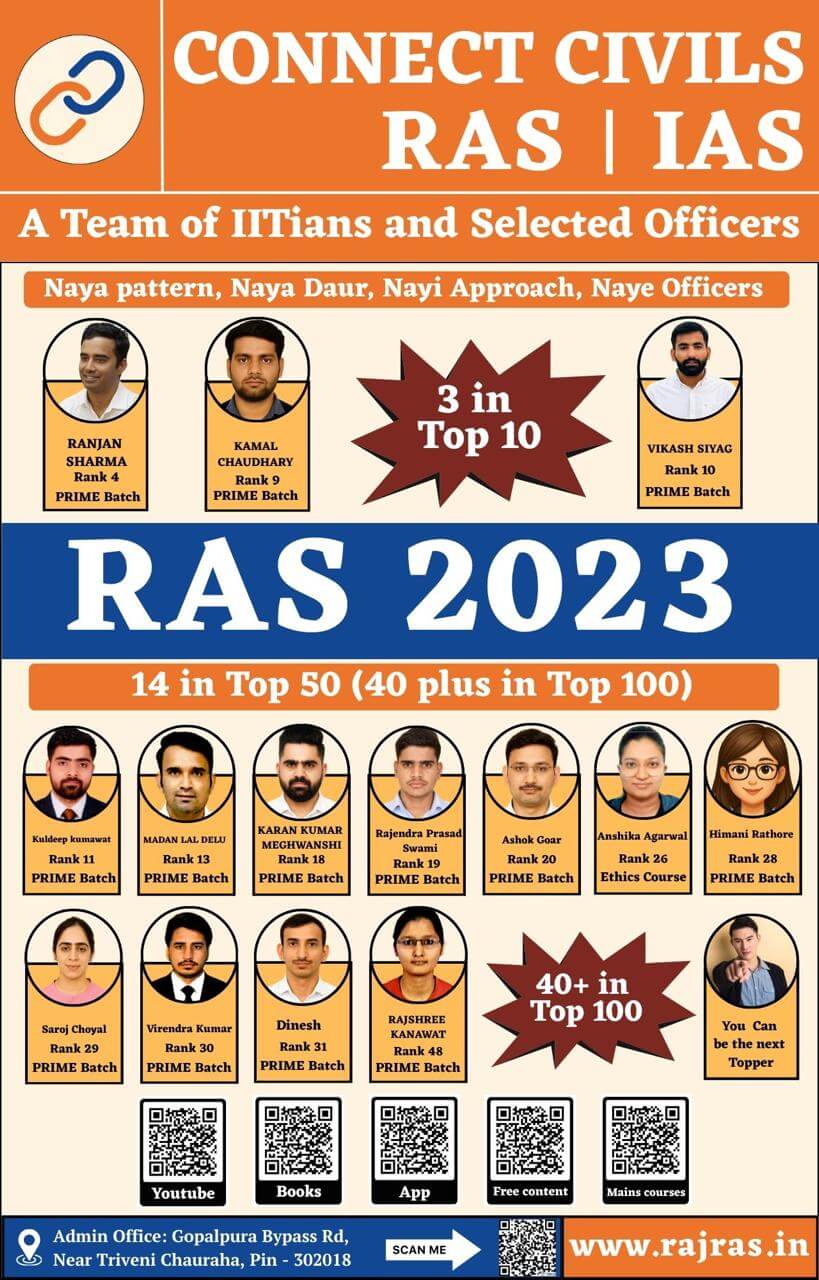In Rajasthan Geography, Rajasthan’s climate, marked by extreme heat and low rainfall, ranges from Jaisalmer’s arid Thar Desert to Udaipur’s semi-arid zones. Classified as arid, semi-arid, and sub-humid, it shapes agriculture and settlement.
Previous Year Question
|
Year |
Question |
Marks |
|
2013 |
Divide Rajasthan into Agro-climatic regions and describe any one in detail. |
20 M |
General Introduction
- Climate is the long term phenomena taking place in the atmosphere surrounding earth,it is decided on the basis of average 30 years weather conditions.
Characteristics of Rajasthan climate
- Region wise diversity in climate is seen.
- Subtropical Climate condition is found in Rajasthan।
- Average climate is arid and semi-arid
- Rainfall – Avg 58 cm annually
- About 90% rainfall received in summer months (June-July) during southwest monsoon।
- Very less 3% from western disturbance।
- Irregular and uncertain (1000cm over southeastern parts to 14 cm over extreme northwestern parts)।
- Scarce- drought famines are common।
- Temperature – extreme temperature during summer(30-40°C) and winters (10-12°C)
- Daily temperature variations are also high(Jaisalmer); sand gets easily heated up and cooling is also fast
- Wind direction change with change in seasons
- Diverse physical reliefs also put great impact on climate and local humidity
- Winds from western plateau of Baluchistan also affect climate making it dry, less humid and consequently resulting in less rainfall.
Factors affecting climate of Rajasthan
- Latitudinal location- 23°3’N to 30°12’N।
- Subtropical location.
- Higher temperature variations.
- Distance from sea
- Continental climate- warm and dry
- Height from seafloor and reliefs
- Most regions are less than 370m height from sea level, therefore high temperature and less humidity
- Hadoti plateau and Aravalli range are high, therefore high humidity and high rainfall
- 60% part of state is desert (sandy soil); high daily and seasonal temperature difference; summer (loo) winter (too cold winds)
- Location of Aravalli range (southwest to north east)
- Parallel to southwest monsoon winds from Arabian sea (no obstruction therefore pass without rainfall)
- Blocks Bay of Bengal branch therefore rainfall in eastern and southeastern parts
- Western parts being rain shadow region, doesn’t receive adequate rainfall
- Natural vegetation
- Affects climate and is affected in return
- Affects temperature, humidity
- Most areas of Rajasthan have less and scattered vegetation, therefore rainfall is less
Seasonal Classification of climate
There are four types of Seasons found in Rajasthan
- Summer Season (March – June)
- Rainy Season (June – September)
- Autumn Season (October – November)
- Winter Season (December – Febuary)
Summer Season
- With the start of summer solstice-more vertical sun rays fall over the state,resulting in high temperature therefore low air pressure
- Average temperature 38°C (western districts 45°-48°C)
- Local hot wind flow called as LOO (due to advection flow of wind-horizontal)
- Sandstorms also occur very commonly (due to convectional flow of wind-vertical)
- Bhabhulya (due to spiral or cyclonic winds)
- Least humidity is found during this season
Rainy Season/Monsoon
- Arrival 25th June (@banswara, Dungarpur)
- Retreat 30th September
- Average annual rainfall 57.5cms (india-125cms)
- Monsoon rains contribute 90% of Rajasthan’s annual rainfall
- Southwest monsoon is divided into two branches- Arabian sea branch and Bay of Bengal branch.
- Arabian sea branch again divides into 3 branches- western ghat, Chota Nagpur, Himachal branch (causes first rain in Rajasthan which is very low).
- Bay of Bengal branch divides into two branches- eastern Himalaya branch and Western Great northern-plain branch (brings maximum rainfall in Rajasthan )
- EL-NINO- is a hot oceanic current occurring during the last week of December, which weakens monsoon in India and Rajasthan also(also known as Ocean fever / Child of Christ)
- LA-NINA-is cold oceanic current occurring during the last week of December, which makes monsoon strong for India and Rajasthan also (also known as younger sister of EL – Nino)
Autumn season
- Retreating of Monsoon (withdrawal of monsoon)
- Kartik heat (increase in temperature when the Monsoon is retreating)
- Oct-nov months
- Minimum daily temperature difference
Winter season
- High pressure and low temperature
- December to March
- Cold winds from Himalayas
Mavath
- winter rainfall during month of December to march, brought by western disturbances from Mediterranean sea(western jet stream flowing at low latitudes); called as golden drops(blessing for rabi crops) ;
- contributes 10% of Rajasthan’s annual rainfall
- also called as temperate monsoon/winter monsoon/ Mediterranean monsoon/north west monsoon.
Climate Classification

General Classification of Climate
Rajasthan is divided into five parts on the basis of Rainfall & Temperature –

| Climatic region | ARID | SEMI ARID | SUB HUMID | HUMID | VERY HUMID |
| Temperature (summer) | 35-40°C | 32-36°C | 28-34°C | 32-35°C | 30-34°C |
| Temperature (winter) | 12-16°C | 10-17°C | 12-18°C | 14-17°C | 12-15°C |
| Rainfall | 0-20cms | 20-40cms | 40-60cms | 60-80cms | 80-150cms |
| Vegetation | Xerophytes and thorny bushes | Steppe type, bushes, khejari, rohida, leelan & sevan grasses | Neem, babool, mango, amla, wheat, barley, gram,mustard | Dense vegetation, rose, neem, mango, rice, jowar, sugarcane | Savannah type sagwan, seesam, cotton |
| Physical division | North-Western Desert | North-Western Desert | Aravalli | Eastern Plain | Hadoti Plateau & Mahi Besin |
| miscellaneous | Sand dunes Sand storms and Loo | Inland drainageSalt water lakes | |||
| Expansion Areas | Jaisalmer, Bikaner, Northern Barmer, Phalodi, Northwestern Jodhpur, Western Nagaur, Western Churu, Southern Sri Ganganagar | Sri Ganganagar, Hanumangarh, Sikar, Jhunjhunu, Churu, Nagaur, Didwana-Kuchaman, Jodhpur, Pali, Jalore | Khairthal-Tijara, Kotputli-Behror, Jaipur, Dausa, Alwar, Tonk, Ajmer, Beawar, Bhilwara, Sirohi | Bharatpur, Deeg, Sawai Madhopur, Karauli, Dholpur, Bundi, Rajsamand, Chittorgarh | Jhalawar, Kota, Baran, Pratapgarh, Banswara, Dungarpur, Mount Abu, Southern Udaipur, Southern Salumber, Southern Baran |
Individual Classification
By Koppen
According to Koppen Climate of Rajasthan is divided into four parts based on Vegetation, Temperature and Rainfall.


| CLIMATIC REGION | Aw | BWhw | BShw | Cwg |
| Climate – | Tropical Humid / Very Humid | Arid Desert | Semi Arid | Sub-Tropical , Sub – Humid |
| Vegetation | Savanna Type | Xerophytes and Thorny Vegetation | Steppe Grassland | Dry Deciduous |
| Area | Vagad (Banswara, Dungarpur, Pratapgarh), Hadoti (Southern Kota, Baran, Jhalawar), Mount Abu, Partial Chittorgarh | Jaisalmer, Bikaner, Churu, Sriganganagar, Hanumangarh. | Luni Basin, Nagaur, Shekhawati, Ghaggar Basin | Alwar, Bharatpur, Deeg, Karoli, Dholpur, Ajmer, Bhilwara, Bundi, Chittorgarh, Dausa, Rajsamand, Tonk, Swai-Madhopur, Udaipur, Jaipur, Gangapur City |
| Mics | maximum Vegetation density | Minimum Rainfall and Thorny Vegetation | largest climate zone | Maximum Population density,Maximum agricultural production |
By Thornthwaite
Rajasthan’s climate is divided into four parts based on the Temperature, Evaporation and Rainfall.

| CLIMATIC REGION | CA’w | DA’w | DB’w | EA’d |
| Climate | Humid | Semi-arid | Arid and Semi-arid | Dry arid |
| Area | Banswara, Dungarpur, Pratapgarh, Jhalawar, Baran and South Kota and Partial Chittorgarh. | Alwar, Bharatpur, Karauli, Dholpur, Ajmer, Bundi, Bhilwara, Chittorgarh, Dausa, Jaipur, Nagaur and Pali | Bikaner, Churu, Ganganagar, Hanumangarh. | Jaisalmer, Barmer, Balotra, West Jodhpur, Bikaner and Phalodi. |
| Mics | largest climatic region |
By Trewartha
Rajasthan’s climate is divided into four parts based on Rainfall.
Climatic Regions of Rajasthan
| Climate Type | Annual Rainfall (cm) | Major Districts |
| Aw – Tropical Humid Climate | 80-100 cm | Banswara, Salumber, Eastern Udaipur, Dungarpur, Pratapgarh, Chittorgarh, Baran, Jhalawar, Southern Kota |
| BSh – Tropical Semi-Arid Climate | 40-60 cm | Western Udaipur, Hanumangarh, Rajsamand, Sirohi, Jalore, Southeastern Barmer, Jodhpur, Pali, Ajmer, Nagaur, Churu, Jhunjhunu, Sikar, Sri Ganganagar, Bikaner, Western Bhilwara |
| BWh – Tropical Desert Climate | 10-20 cm | Jaisalmer, Southwestern Bikaner, Northwestern Barmer |
| Caw – Subtropical Climate | 50-80 cm (Winter Rain due to Cyclones) | Kota, Bundi, Baran, Tonk, Sawai Madhopur, Karauli, Bharatpur, Dholpur, Alwar, Dausa |
Climate – Characteristics and Their Classification / Climate – Characteristics and Their Classification / Climate – Characteristics and Their Classification / Climate – Characteristics and Their Classification / Climate – Characteristics and Their Classification / Climate – Characteristics and Their Classification

